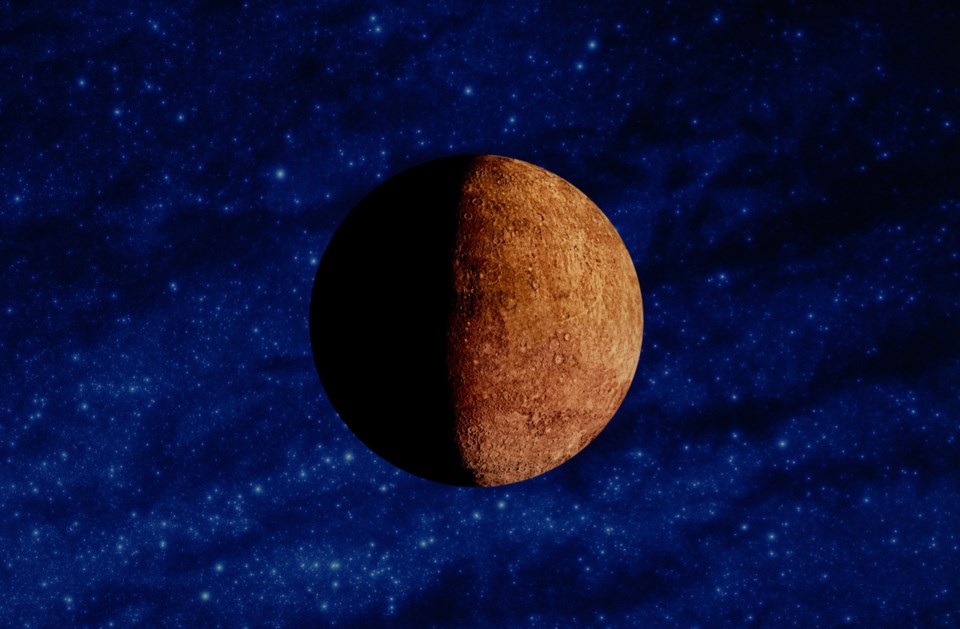I hope everyone has had the chance to see the Andromeda Galaxy through binoculars after last month’s star-hopping lesson. The chart that accompanied the article was a screen capture of Stellarium, which proves again that everyone who is interested in astronomy should download the program and get familiar with it. The price is certainly right.
This summer hasn’t been as spectacular as 2020 with its glorious Comet NEOWISE but October presents us with arguably the best morning apparition of Mercury of the year for those of us in the Northern Hemisphere. Few people ever see Mercury and identify it since it’s the most difficult of the naked-eye planets to see. It’s always close to the Sun and it moves quickly enough that you can lose it with only a few days of clouds. Mercury is at inferior conjunction on Oct. 9 – between us and the Sun – and by mid-month is visible just south of due east at about 0645. It reaches perihelion – closest to the Sun – on Oct. 19 and will reach its greatest western elongation on Oct. 25 when it will be just 18.4 degrees west of the Sun. Mercury’s orbit is quite elliptical so this morning appearance will be close to the Sun and fast. It will still be visible into November although it will be lower each morning as it heads back around the Sun. Nov. 3 will be interesting, however. Mercury will be very low to the ESE horizon – about 3 degrees (two fingers width) above the horizon and will hang just below a waning crescent Moon and at 0700 will be passed by the International Space Station heading below the eastern horizon!
If the sky is clear and you’re up for an interesting challenge, try this: at 1300 on Oct. 9 look for a new crescent Moon almost due southeast and about eight degrees above the horizon (almost a fist-width). Look about three moon diameters below and right of the Moon – at about 4 o’clock to the Moon – and look for a bright object. If you can see it naked-eye, pat yourself on the back; if you can’t see anything, grab the binoculars and try again. The bright object is Venus and it should be easy to see (at least in binoculars).
If that didn’t work, wait until about 1900 that same day and look due southwest about the same height above the horizon. You should be able to see the Moon and Venus a little further apart but if you wait until about 1905, you should be able to see the International Space Station heading west to east just below the crescent Moon. Please note that these predictions can be off a bit because NASA routinely adjusts the orbit of the ISS to compensate for the slight drag caused by the trace atmosphere at 250 miles up.
The Moon passes below Saturn and Jupiter on the 13th and 14th, respectively. If you have steady binocular hands (or a tripod), here are some neat views of Jupiter’s moons over the month:
• Oct 2: all 4 left of Jupiter: G, C, E, I.
• Oct 4: all 4 right of Jupiter: I, G, C, E (after 2100).
• Oct 15: 2 left, 2 right: C, G, Jupiter, I, E (widely spread out).
• Oct 16: all 4 left of Jupiter: C, G, I, E (before 1900).
• Oct 26: all 4 right of Jupiter: I, E, G, C (before 1800) – in orbital order!
Note:
1. I is Io, E is Europa, G is Ganymede and C is Callisto, from innermost to outermost of Jupiter’s four big moons.
2. If this reminds you of the topic of my March 2021 article on Jupiter’s moons, good! It should also whet your appetite for the topic of our next Club Zoom meeting on Oct. 8. I’m really looking forward to it.
Remember, all of the movements of moon and planets described can be checked out on the web at: heavens-above.com. The next regular meeting of the Astronomy Club will be Oct. 8 at 7:30 p.m. using Zoom. The speaker for the evening will be Richard Mitchell of the Sunshine Coast Astronomy Club and his topic will be “Celestial Navigation, the Role of Astronomy in Navigation through the Ages.” How to register for the meeting will be on the club website at sunshinecoastastronomy.wordpress.com the week of the meeting.



